7 recipes from The Happy Kitchen by Rachel Kelly
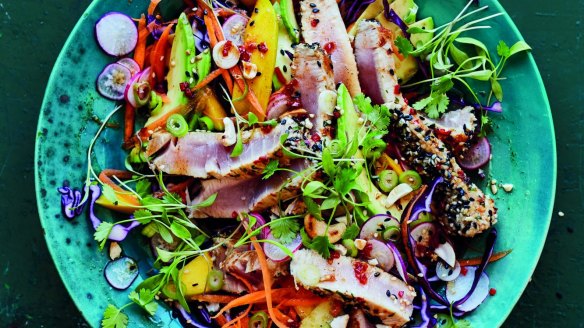
Eat yourself happy; now that sounds like a recipe for good living, doesn't it? If only it were that simple. Fortunately writer (now mental health campaigner) Rachel Kelly, and nutritionist Alice MackIntosh have teamed up to help simplify the correlation between diet and mental wellbeing.
The pair, co-authors of The Happy Kitchen, first met when Kelly was struggling with depression and anxiety, which she partly attributes to her former career as a news reporter at The Times newspaper in London. Kelly's GP used the term "happy food" which led her to seek out a nutritional therapist (MackIntosh) as part of her recovery plan.
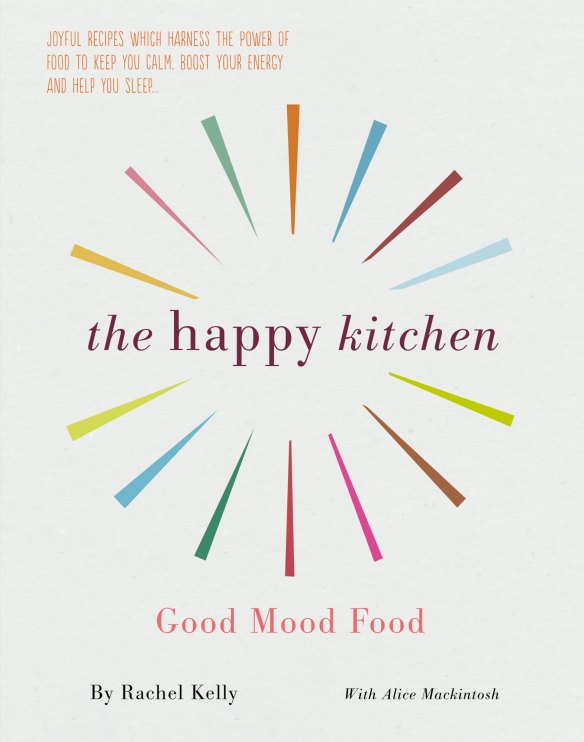
Kelly and MackIntosh have spent years writing The Happy Kitchen, which incorporates information and recipes backed up by more than 150 studies.
On a recent rip to Australia to promote the book, Kelly said there is still much work to be done to increase understanding about nutrition, and how diet can be used to help treat mental health issues. She says she now uses diet as one of the tools to keep depression and anxiety at bay, although she cautions that people need to take a holistic approach to tackling mental health problems.
"The truth is nutrition works in conjunction with other things. Stress management, for example, is very important for nutrition." Kelly says one of the first things she did with MackIntosh to address stress factors in her own life was to draw up a timetable to map out "when, why and how I was eating".
Making time to eat calmly rather than wolfing food down is one change busy people can make to help their digestive systems function better.
The Happy Kitchen is chock full of meal planners, and covers off on how nutrition can assist people suffering - among other ailments - depression, anxiety and sleep disorders. Here are some sample recipes from the 'Beating the Blues', 'Nice and Calm' and 'Comfort Food' meal planners.
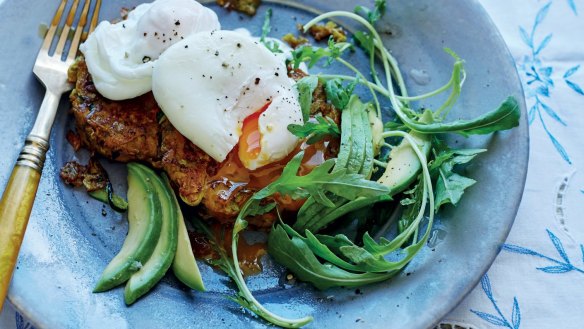
The good-mood meal planner
Sweet potato and zucchini fritters with poached eggs
Eggs supply amino acids, B vitamins and folate, while the sweet potatoes make this recipe wonderfully filling and there's plenty of fibre in the zucchinis. Ensure the oil is sizzling hot before you add the fritters so that they're crispy and golden.
5 eggs (2 for poaching)
300g sweet potato (approximately 1 large potato), peel on and grated
100g zucchini (approximately ½ zucchini), grated
3 spring onions, chopped
1 garlic clove, finely chopped
1 teaspoon ground turmeric
3 tablespoons flour (ideally wholegrain such as spelt or buckwheat)
2 teaspoons black mustard seeds
2 tablespoons oil, for frying (enough for approx 1 teaspoon per fritter) – coconut or butter work well
2 tablespoons sour cream or Greek yoghurt, to serve
Method
1. Whisk three eggs and combine them with the grated sweet potato, grated zucchini, spring onions, garlic, turmeric, flour and black mustard seeds.
2. Divide the sweet-potato mixture into 6-8 well compressed patties, around 10cm across and no more than 2cm thick to ensure they cook through properly.
3. Heat 1 teaspoon of coconut oil or butter in a pan and cook the patties for four minutes on each side, or until they are dark golden brown.
4. Meanwhile, boil some water in a deep frying pan with a dash of white-wine vinegar. Crack an egg into a cup and then gently add it to the water, using the end of a wooden spoon to guide the white towards the yolk to keep them together. Do the same with the other egg, or use an egg poacher if you have one.
5. Put the fritters on a plate, place the eggs on top (having drained the water off first) and serve with a dollop of Greek yoghurt or sour cream. For a colourful lunch, add some rocket or sliced avocado.
Serves 2 (with leftovers)
Happy smoothie
This is a great light breakfast or afternoon snack, with raw cacao powder as a tasty ingredient. Cocoa powder is a decent substitute, but isn't thought to have as many health-giving properties. Cacao contains magnesium and other antioxidants, and there has been much interest recently in its potential benefits, including its effect on blood pressure. The yoghurt and pumpkin seeds provide tryptophan and the banana serotonin which explains this smoothie's name.
½ medium banana
½ cup raspberries (frozen is fine)
Handful of fresh spinach leaves, washed
2 tablespoons natural yoghurt
½ teaspoon ground cinnamon
1 dessertspoon raw cacao powder, or good quality unsweetened cocoa powder
1 dessertspoon pumpkin seeds
Milk, or dairy-free alternative, to top up
1 dessertspoon maple syrup or honey
to sweeten (optional)
Method
1. Combine all the ingredients in a blender and blitz until smooth.
Serves 1
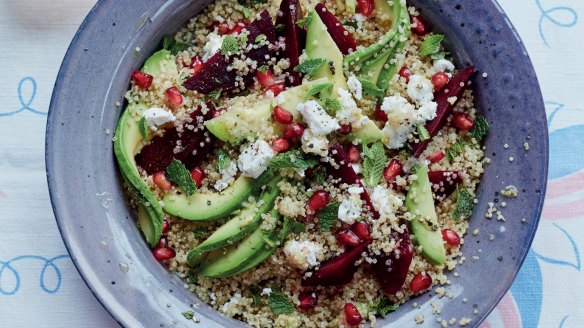
Many recipes use these ingredients, but we hope you will like our version. It contains a good balance of carbohydrates, fats and protein to stop you waking from hunger in the night.
350g quinoa
3 medium-sized cooked beetroots
2 ripe avocados
100g soft goat's cheese with rind
3 tablespoons pomegranate seeds
1 tablespoon olive oil
Juice of ¼ lemon
Method
1. Wash the quinoa thoroughly under a tap in a sieve before putting it in a saucepan with roughly double the quantity of water to quinoa.
2. Bring it to the boil, then turn the heat down and leave it to simmer gently for 12-15 minutes. At this point most of the water should have been absorbed, so turn off the heat and leave it to steam for 5 minutes with the lid on.
3. Taste the grains to check they are cooked. They should be a little nutty but not overly crunchy or starchy, and translucent in appearance. Leave them to cool.
4. While the quinoa is cooking, dice the beetroot into small cubes, similar in size to the pomegranate seeds. This is time-consuming but worth the effort.
5. Do the same with the avocado.
6. Cut the goat's cheese into slightly bigger pieces than the beetroot and the avocado.
7. When the quinoa is no longer piping hot, stir through three-quarters of the beetroot, goat's cheese, pomegranate seeds, olive oil and lemon juice.
8. Serve the salad in a dish or on plates and sprinkle over the remaining ingredients. The avocado is best left until last so it doesn't heat up too much and go soft.
Serves 2 to 4
Sundried tomato hummus
I always have a pot of hummus in the fridge to use for a snack or to add to a salad. It is rich in vitamin B6 and magnesium, which as we have seen, have anxiety relieving effects, and our version avoids the extra sugar, salt and vegetable oil of some shop-made varieties. Tahini is a Middle Eastern spread made from toasted sesame seeds. This recipe works equally well with roasted red peppers and I sometimes switch the chickpeas for lentils or haricot beans if I fancy a change. Get experimenting.
120g (drained weight) sundried tomatoes in oil
400g tin chickpeas, drained
Juice of ½ lemon
2 tablespoons light tahini
2 tablespoons olive oil
1 teaspoon paprika
Method
1. Let the excess oil drain off the sundried tomatoes. I use a kitchen towel for this.
2. Put all the ingredients in a food processor and blitz until you have a smooth paste. Add a bit more lemon juice or tomato according to taste.
3. Add a little extra olive oil or a splash of water to loosen the hummus if it feels too thick.
4. Serve it with warm pitta bread or crudités. Or both!
Serves 4 to 6
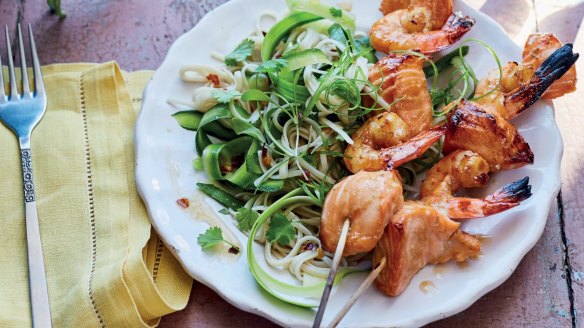
A rather exotic recipe, which is rich in omega-3s and introduced me to several new flavours that I now like. Japanese teriyaki sauce – made from soy sauce, sake, sugar and ginger – is probably the most basic of Asian marinades. If you can't get hold of teriyaki sauce, add three parts soy sauce (or tamari) to two parts maple syrup or honey. Soba noodles are made of buckwheat and have a low GI, but do use wholegrain if you can't find them. Japanese mirin is a type of rice wine, which is high in sugar and used here to add sweetness to the dish.
For the skewers
5 tablespoons teriyaki sauce
Juice and zest of 1 lime
2 tablespoons sesame oil
1 garlic clove, finely chopped
1 teaspoon root ginger, chopped
1 tablespoon Japanese mirin (optional, to add sweetness)
2 salmon fillets, skinned and sliced into
5cm chunks
150g fresh king prawns (use smaller ones if you can't get king size, but ensure they are raw)
4 wooden or metal skewers (soak wooden ones
in water before use to prevent charring)
For the noodles
1 zucchini
200g soba noodles
Juice of 1 lime
1 tablespoon sesame oil
1 teaspoon teriyaki sauce
½ teaspoon dried chilli flakes
To serve:
Handful of fresh coriander, chopped
1 spring onion, finely sliced
1 tablespoon roasted sesame seeds (optional)
Method
1. In a large bowl, mix the teriyaki sauce, lime juice and zest, sesame oil, garlic, ginger and mirin. Place the salmon and prawns in the sauce. Marinate in the fridge for at least an hour.
2. Use a spiraliser to cut the zucchini into ribbons or use a bag of shop-bought 'courgetti'.
3. When you are ready to eat, heat the grill to around 180°C or fire up the barbecue. Slide the fish and prawns onto the skewers.
4. Put the noodles in a big pan of boiling water and cook for 3-5 minutes. When they are soft, drain them and run them under cold water (this stops them from sticking together). Set them aside.
5. Grill the skewers for 4-6 minutes, turning them halfway through and taking care not to overcook them.
6. Put the noodles back in the pan on a low heat and stir in the zucchini ribbons and the rest of the ingredients, and gently heat them through for 3-5 minutes.
7. Serve the skewers on the noodles, with a sprinkling of coriander, spring onion and sesame seeds.
Serves 4
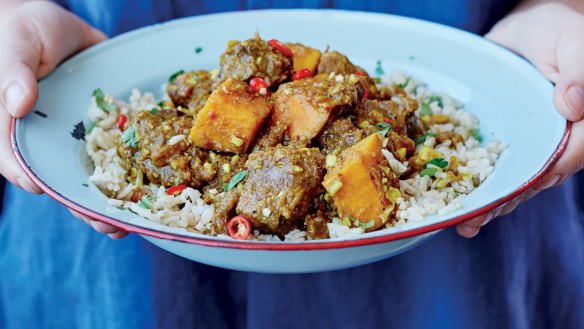
Thanks to the reader who pointed out we were missing the method for this recipe. All fixed now! GF
This recipe is inspired by beef randang, the popular Malaysian dish served on high days and holidays, and although it contains a lot of ingredients, it is actually quite easy to make. Almonds are a source of magnesium, while ginger, chilli, turmeric and garlic all contain antioxidants, and the spices add a lovely depth of flavour to the dish. If you are a vegetarian, try substituting the lamb with chickpeas: they, like the lamb, contain iron, fibre and B vitamins. Cooking time for the chickpeas – if you go with the dried variety, rather than a tin – is around an hour, and you may have to soak them beforehand too. Once all the preparation is out of the way, the dish slowcooks in the oven without needing any help and can be eaten the next day.
For the curry paste
2 red onions, roughly chopped
6 garlic cloves
2 lemongrass stalks, white parts only with the tough outer layer removed
4 red chillies, deseeded (if you like it hot, keep the seeds in 2 of the chillies)
1 tablespoon liquid coconut oil Handful of fresh coriander, stalks only (the leaves can be saved for the rice)
60g root ginger, roughly chopped
20g fresh turmeric (many Asian supermarkets sell this) or 2 teaspoons ground turmeric
2 teaspoons ground coriander
1 teaspoon ground cumin
1 dessertspoon maple syrup or palm sugar
For the curry
4 star anise
2 cinnamon sticks
600g lamb leg (boneless), diced
1 medium-sized sweet potato, cut into 3cm chunks
400ml coconut milk
50ml water
1 tablespoon tamarind paste
4 kaffir lime leaves
Juice and zest of 1 lime
100g raw almonds
50g coconut flakes, or desiccated coconut
For the coriander rice
250g wholegrain or brown rice
600ml water
4 cardamom pods
Large handful of fresh coriander, finely chopped
Method
1. Preheat the oven to 140°C.
2. Place all the paste ingredients in a food processor and blend to form a smooth purée, or crush up well using a use a pestle and mortar.
3. Heat a heavy-based casserole (with a lid) and fry the paste over a high heat for 2 minutes.
4. Add the star anise and cinnamon sticks and cook for another minute, then stir the meat into the mixture so that it gets a good coating.
5. Add the sweet-potato chunks, coconut milk, water, tamarind paste, kaffir lime leaves and lime juice and zest, and give it a good stir.
6. Put the curry in the oven for an hour and a half to two hours, stirring it halfway through and checking it isn't cooking too quickly – it should be gently simmering, not boiling.
7. Meanwhile, use the food processor to chop up the almonds. Pulse until they are broken up into small pieces.
8. After 2 hours, take the curry out and stir in the almonds. The meat should already be nice and tender. If the mixture is still quite liquid, you can take the lid off before putting it back into the oven for the last 20 minutes, otherwise leave it on. I recommend giving the dish around 15 minutes to rest before serving, so keep this in mind when cooking the rice. If there is a layer of fat on top of the curry use a spoon to remove some of it.
9. For the rice, start by rinsing it well in a sieve under the tap. Transfer it to a pan with the water and cardamom pods, bring it to the boil, then reduce the
heat and put the lid on. Cook it on a gentle heat for 20 minutes.
10. You should start to see air bubbles form in the rice where the air is escaping, and at this point most of the water should have gone. Stir in the chopped coriander, replace the lid and allow it to steam for 5 minutes with the heat turned off.
11. Fish out the cardamom pods, then serve the rice with the curry on top, doing your best to avoid the cinnamon sticks and star anise. Garnish with some chopped fresh red chilli if you like it hot.
Serves 4 to 6
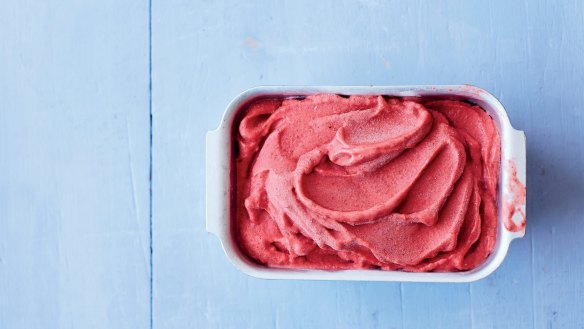
Strawberry sorbet
I sometimes have this for breakfast! I have found that frozen strawberries work best, as you don't need to add any extra ice. Its fuchsia colour is probably my favourite thing about this recipe. For added berry bliss, scatter some blueberries or blackberries on top before serving.
150g frozen strawberries
2 tablespoons Greek yoghurt
1 tablespoon maple syrup
Method
1. Blitz the strawberries, Greek yoghurt and maple syrup in a blender or food processor for about 40 seconds, or until smooth.
2. Taste. If you have used tarter strawberries, or want the sorbet sweeter, add a little more maple syrup. Too much can make the sorbet too runny, though, so be careful. Add more yoghurt if you want a looser consistency.
3. Eat it straightaway, perhaps garnished with a sprig of mint.
If you want to save the sorbet for later, pour it into ice cube trays or ramekins and freeze it. Use a knife to loosen the blocks when you are ready to eat them, and blend them in a food processor for 30-60 seconds. Then scoop the sorbet out and serve it immediately.
Serves 2
Edited extract from The Happy Kitchen by Rachel Kelly and Alice Mackintosh (Simon and Schuster, $35), available now.
The best recipes from Australia's leading chefs straight to your inbox.
Sign up